标签:des style blog http color io os ar for
A method and processor for providing full?load/store?queue?functionality to an unordered?load/store?queue?for a processor with out-of-order execution.?Load and?store?instructions are inserted in a?load/store?queue?in execution order. Each entry in the?load/store?queue?includes an identification corresponding to a program order. Conflict detection in such an unordered?load/store?queue?may be performed by searching a first CAM for all addresses that are the same or overlap with the address of the?load?or?store?instruction to be executed. A further search may be performed in a second CAM to identify those entries that are associated with younger or older instructions with respect to the sequence number of the?load?or?store?instruction to be executed. The output results of the Address CAM and Age CAM are logically ANDed.
The present invention relates to?load/store?queues, and more particularly to an unordered?load/store?queue?for a processor with out-of-order execution.
A conventional processor in an information handling system may include several pipeline stages to increase the effective throughput of the processor. For example, the processor may include a fetch stage that fetches instructions from memory, a decoder stage that decodes instructions into opcodes and operands, and an execution stage with various execution units that execute decoded instructions. Pipelining enables the processor to obtain greater efficiency by performing these processor operations in parallel. For example, the decoder stage may decode a fetched instruction while the fetch stage fetches the next instruction. Similarly, an execution unit in the execution stage may execute a decoded instruction while the decoder stage decodes another instruction.
The simplest processors processed instructions in program order, namely the order that the processor encounters instructions in a program. Processor designers increased processor efficiency by designing processors that execute instructions out-of-order. Designers found that a processor can process instructions out of program order provided the processed instruction does not depend on a result not yet available, such as a result from an earlier instruction. In other words, a processor can execute an instruction out-of-order provided that instruction does not exhibit a dependency.
To enable a processor to execute instructions out-of-order, the processor may include a "load/store?queue." With the?load/store?queue,?load?and?store instructions are able to be executed in order relative to one another. Entries in the?load/store?queue?may be established for?load?and?store?instructions in program order as the instructions are fetched. For example, as a new?load?or store?instruction is fetched, an entry is created for that?load?or?store?instruction at the tail end of the?load/store?queue. The?load/store?queue?continues to hold this instruction until it has been committed (i.e., irrevocable) or nullified through misspeculation. Hence, the?load/store?queue?holds each?load?and?store instruction that are currently in-flight until that particular?load?or?store?instruction has been committed or nullified through misspeculation.
As discussed above, the?load?and?store?instructions are stored in the?load/store queue?after they have been fetched. Once the?load?or?store?instruction is ready to be executed, there may be a search performed in the?load/store?queue?to ensure that there would not be a violation in executing that?load?or?store instruction. For example, if a?load?instruction is to be executed, a search may be performed in the?load/store?queue?to locate older (referring to being fetched prior to the?load?instruction in question)?store?instructions to the same or overlapping address that have not been committed to determine if the correct data to be loaded has already been stored. In another example, if a?store instruction is to be executed, a search may be performed in the?load/store?queue to locate any younger (referring to being fetched after the?store?instruction in question)?load?instructions to the same or overlapping address that have been executed. If that has occurred, all of the pipelines are flushed.
Since the?load/store?queue?has to?store?all the?load?and?store?instructions from the time they have been fetched to the time they have been committed, theload/store?queue?has to be large in size to accommodate these?load?and?store instructions. Hence, the?load/store?queue?is not currently scalable by requiring to hold?load?and?store?instructions in program order from the time they have been fetched to the time they are committed.
However, if the?load/store?queue?could be scaled smaller in size, then the area and power efficiency of the?load/store?queue?may be improved.
In one embodiment of the present invention, a method for providing full?load/store queue?functionality to an unordered?load/store?queue?for a processor with out-of-order execution comprises inserting?load?and?store?instructions in one or more load/store?queues in non-program order, where each entry in the one or more load/store?queues comprises an identification corresponding to a program order.
The foregoing has outlined rather generally the features and technical advantages of one or more embodiments of the present invention in order that the detailed description of the present invention that follows may be better understood. Additional features and advantages of the present invention will be described hereinafter which may form the subject of the claims of the present invention.
A better understanding of the present invention can be obtained when the following detailed description is considered in conjunction with the following drawings, in which:
FIG. 1?is a hardware configuration of a computer system configured in accordance with an embodiment of the present invention;
FIG. 2?illustrates an embodiment of the present invention of a processor of the computer system;
FIG. 3?illustrates storing instructions in execution order in a?load/store?queue?in accordance with an embodiment of the present invention;
FIG. 4?illustrates an embodiment of the present invention of the?load/store queue;
FIG. 5?illustrates the internal architecture of the?load/store?queue?in accordance with an embodiment of the present invention;
FIGS. 6A-B?are a flowchart of a method for providing full?load/store?queue functionality to an unordered?load/store?queue?in connection with arriving?load instructions for a processor executing instructions out-of-order in accordance with an embodiment of the present invention; and
FIG. 7?is a flowchart of a method for providing full?load/store?queue?functionality to an unordered?load/store?queue?in connection with arriving?store?instructions for a processor executing instructions out-of-order in accordance with an embodiment of the present invention.
The present invention comprises a method and processor for providing full load/store?queue?functionality to an unordered?load/store?queue?for a processor with out-of-order execution. In one embodiment of the present invention,?load and?store?instructions are inserted in one or more?load/store?queues in execution order. Each entry in the?load/store?queue?includes an identification corresponding to the program order. Conflict detection (e.g., determining if any violations occurred) in such an unordered?load/store?queue?(which may include separate load?and?store?queues) may be performed by using two content addressable memories. One content addressable memory, referred to herein as the "Address CAM," may include addresses of the?load?or?store?instructions executed. The other content addressable memory, referred to herein as the "Age CAM," may include the sequence number (i.e., the program order) of the?load?or?store instructions executed. A search may be performed in the Address CAM for all addresses that are the same or overlap with the address of the?load?or?store instruction to be executed. A further search may be performed in the Age CAM to identify those entries that are associated with younger or older instructions with respect to the sequence number of the?load?or?store?instruction to be executed. The output results of the Address CAM and Age CAM are logically ANDed. Since the entries in the Address CAM and the Age CAM are correlated, the loads and stores to the same address are physically co-located with one another thereby allowing address comparison and the ability to perform a conflict detection analysis.
In the following description, numerous specific details are set forth to provide a thorough understanding of the present invention. However, it will be apparent to those skilled in the art that the present invention may be practiced without such specific details. In other instances, well-known circuits have been shown in block diagram form in order not to obscure the present invention in unnecessary detail. For the most part, details considering timing considerations and the like have been omitted inasmuch as such details are not necessary to obtain a complete understanding of the present invention and are within the skills of persons of ordinary skill in the relevant art.
FIG.?1—Hardware Configuration of Computer System
FIG. 1?illustrates an embodiment of a hardware configuration of computer system?100?which is representative of a hardware environment for practicing the present invention. Computer system?100?may have a processor?101?coupled to various other components by system bus?102. A more detailed description of processor?101?is provided below in connection with?FIG. 2. Referring to?FIG. 1, an operating system?103?may run on processor?101?and provide control and coordinate the functions of the various components of?FIG. 1. An application?104in accordance with the principles of the present invention may run in conjunction with operating system?103?and provide calls to operating system?103?where the calls implement the various functions or services to be performed by application104.
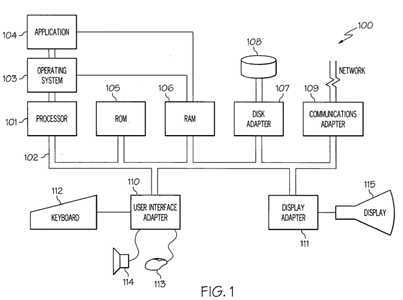
Referring to?FIG. 1, read-only memory ("ROM")?105?may be coupled to system bus?102?and include a basic input/output system ("BIOS") that controls certain basic functions of computer device?100. Random access memory ("RAM")?106and disk adapter?107?may also be coupled to system bus?102. It should be noted that software components including operating system?103?and application104?may be loaded into RAM?106, which may be computer system‘s?100?main memory for execution. Disk adapter?107?may be an integrated drive electronics ("IDE") adapter that communicates with a disk unit?108, e.g., disk drive.
Referring to?FIG. 1, computer system?100?may further include a communications adapter?109?coupled to bus?102. Communications adapter?109?may interconnect bus?102?with an outside network (not shown) thereby allowing computer system100?to communicate with other similar devices.
I/O devices may also be connected to computer system?100?via a user interface adapter?110?and a display adapter?111. Keyboard?112, mouse?113?and speaker114?may all be interconnected to bus?102?through user interface adapter?110. Data may be inputted to computer system?100?through any of these devices. A display monitor?115?may be connected to system bus?102?by display adapter111. In this manner, a user is capable of inputting to computer system?100through keyboard?112?or mouse?113?and receiving output from computer system100?via display?115?or speaker?114.
The various aspects, features, embodiments or implementations of the invention described herein can be used alone or in various combinations. The methods of the present invention can be implemented by software, hardware or a combination of hardware and software.
As discussed above, a detail description of processor?101?is provided below in connection with?FIG. 2.
FIG.?2—Processor
FIG. 2?illustrates an embodiment of the present invention of processor?101?(FIG. 1) configured to execute instructions out-of-order. Processor?101?may include an instruction fetch unit?201?configured to fetch an instruction in program order. Instruction fetch unit?201?may further be configured to?load?the address of the fetched instruction into Instruction Fetch Address Register?202?("IFAR"). The address loaded into IFAR?202?may be an effective address representing an address from the program or compiler. The instruction corresponding to the received effective address may be accessed from Instruction Cache (I-Cache) unit?203?comprising an instruction cache (not shown) and a prefetch buffer (not shown). The instruction cache and prefetch buffer may both be configured to store?instructions. Instructions may be inputted to instruction cache and prefetch buffer from a system memory?217?through a Bus Interface Unit (BIU)?216.
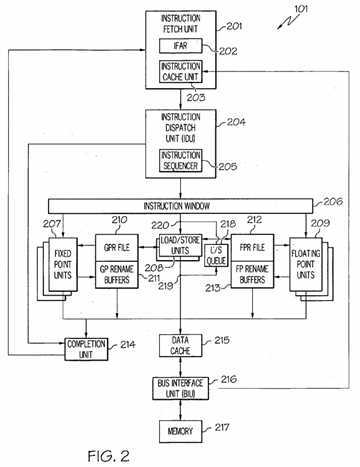
Instructions from I-Cache unit?203?may be outputted to Instruction Dispatch Unit (IDU)?204. IDU?204?may be configured to decode these received instructions. IDU?204?may further comprise an instruction sequencer?205?configured to forward the decoded instructions in an order determined by various algorithms. The out-of-order instructions may be forwarded to one of a plurality of issue queues, or what may be referred to as an "instruction window"?206, where a particular issue in instruction window?206?may be coupled to one or more particular execution units, fixed point units?207,?load/store?units?208?and floating point units?209. Instruction window?206?includes all instructions that have been fetched but are not yet committed. Each execution unit may execute one or more instructions of a particular class of instructions. For example, FXUs?207?may execute fixed point mathematical and logic operations on source operands, such as adding, subtracting, ANDing, ORing and XORing. FPUs?209?may execute floating point operations on source operands, such as floating point multiplication and division. FXUs?207?may input their source and operand information from General Purpose Register (GPR) file?210?and output their results (destination operand information) of their operations for storage at selected entries in General Purpose (GP) rename buffers?211. Similarly, FPUs?209?may input their source and operand information from Floating Point Register (FPR) file?212?and output their results (destination operand information) of their operations for storage at selected entries in Floating Point (FP) rename buffers?213.
As stated above, instructions may be queued in one of a plurality of issue queues in instruction window?206. If an instruction contains a fixed point operation, then that instruction may be issued by an issue?queue?of instruction window?206?to any of the multiple FXUs?207?to execute that instruction. Further, if an instruction contains a floating point operation, then that instruction may be issued by an issue?queue?of instruction window?206?to any of the multiple FPUs?209?to execute that instruction.
All of the execution units, FXUs?207, FPUs?209, LSUs?208, may be coupled to completion unit?214. Upon executing the received instruction, the execution units, FXUs?207, FPUs?209, LSUs?208, may transmit an indication to completion unit?214indicating the execution of the received instruction. This information may be stored in a table (not shown) which may then be forwarded to IFU?201. Completion unit?214?may further be coupled to IDU?204. IDU?204?may be configured to transmit to completion unit?214?the status information (e.g., type of instruction, associated thread) of the instructions being dispatched to instruction window?206. Completion unit?214?may further be configured to track the status of these instructions. For example, completion unit?214?may keep track of when these instructions have been committed. Completion unit?214?may further be coupled to instruction window?206?and further configured to transmit an indication of an instruction being committed to the appropriate issue?queue?of instruction window?206?that issued the instruction that was committed.
In one embodiment, LSUs?208?may be coupled to a data cache?215. In response to a?load?instruction, LSU?208?inputs information from data cache?215?and copies such information to selected ones of rename buffers?211,?213. If such information is not stored in data cache?215, then data cache?215?inputs through Bus Interface Unit (BIU)?216?such information from system memory?217?connected to system bus?102?(FIG. 1). Moreover, data cache?215?may be able to output through BIU?216?and system bus?102?information from data cache?215?to system memory?217?connected to system bus?102. In response to a?store?instruction, LSU?208?may input information from a selected one of GPR file?210?and FPR file?212?and copy such information to data cache?215?when the?store?instruction commits.
Processor?101?is not limited in scope to any one particular embodiment. Further, the principles of the present invention are not confined in scope to any one particular type of processor architecture. The principles of the present invention apply to any processor architecture that includes a?load/store?queue.
Referring to?FIG. 1, processor?101?may include a?load/store?queue?("L/S?queue")?218?configured to?store?load?and?storeinstructions in execution order and not in program order as illustrated in?FIG. 3.?FIG. 3?illustrates storing instructions in execution order in?load/store?queue?218?in accordance with an embodiment of the present invention. For example, referring to the top portion?FIG. 3, suppose at fetch time, a?load?instruction (indicated as "LD" in?FIG. 3) is assigned the sequence number (i.e., the position of the program order) of 1. To be clear, a sequence number is non-contiguous as other non-memory instructions may occur between these?load?and?store?instructions. A?store?instruction (indicated as "ST" in?FIG. 3) is assigned the sequence number of 4. Another?store?instruction is assigned the sequence number of 7. Further, anotherload?instruction is assigned the sequence number of 8. Suppose further that out of these instructions, the?store?instruction with the sequence number of 4 is executed first, followed by the?store?instruction with the sequence number of 7, followed by the?load?instruction with the sequence number of 8 followed by the?load?instruction with the sequence number of 1.
As illustrated in the bottom portion of?FIG. 3, the?load/store?instructions are stored in?load/store?queue?218?in executed order where the?store?instruction executed first (store?instruction with the sequence number of 4) is first enqueued followed by the?store?instruction with the sequence number of 7 followed by the?load?instruction with the sequence number of 8 followed by the?load?instruction with the sequence number of 1.
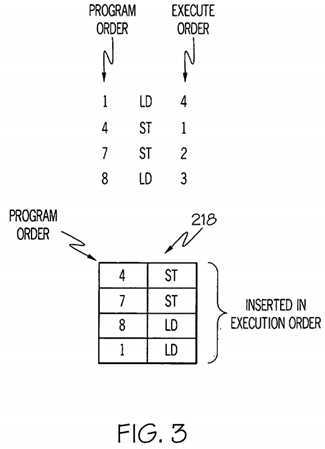
Load/store?queue?218?may perform the following functions. One function is referred to as the "forwarding" function. When a younger?load?instruction arrives later than a?store?instruction to an overlapping address, typically the?store?instruction "forwards" its value to the?load?instruction, combining it with data from a cache (e.g., data cache?215) if necessary. The data from the cache should have a lower priority than the data being forwarded from a?store?instruction.
The second function is referred to as the "violation detection" function. When an older?store?instruction to an overlapping address arrives, it may detect that a younger?load?arrived earlier and has already executed. As a result, the?load?instruction received the incorrect data and the pipeline needs to be flushed, at least back to the?load?instruction and all younger instructions.
The third function is referred to as the "store?buffering" function. When a?store?instruction executes, its value is buffered inload/store?queue?218?until the?store?instruction commits, at which point the?store‘s value is written to the cache (e.g., data cache?215).
As further illustrated in the bottom portion of?FIG. 3, in one embodiment,?load/store?queue?218?may?store?the program order associated with the enqueued?store?or?load?instruction so as to test for violations and to give the perception of being ordered as will be discussed in further detail below in connection with?FIGS. 5,?6A-B and?7.
Returning to?FIG. 2,?load/store?queue?218?may include multiple queues, where one?queue?is designated to?store?loadinstructions and the other?queue?is designated to?store?instructions. While the following discusses?load/store?queue?218?as being a single unit, the principles of the present invention apply to a?load/store?queue?that includes separate queues for storing the?load?and?store?instructions. In one embodiment, the?load?and?store?instructions may be loaded into?load/storequeue?218?at the time the effective addresses are computed, such as at point?219?in?FIG. 2. In another embodiment, theload?and?store?instructions are loaded into?load/store?queue?218?when the instructions are issued, such as at point?220?inFIG. 2. Since the?load?and?store?instructions are enqueued in?load/store?queue?218?when effective addresses are computed or when the instructions are issued and are not enqueued as the instructions are fetched, there is a delay in inserting the instructions which allows the?load/store?queue?to be smaller in size. As a result, processor performance and power efficiency is improved.
Load/store?queue?218?may further be scaled by dividing?load/store?queue?218?into a plurality of banks as discussed below in connection with?FIG. 4.
FIG.?4—Load/Store?Queue
FIG. 4?illustrates an embodiment of the present invention of?load/store?queue?218?(FIG. 2).?Load/store?queue?218?may include a plurality of banks?401A-D, where each bank may be configured to?store?load?and?store?instructions over a range of addresses. Banks?401A-D may collectively or individually be referred to as banks?401?or bank?401, respectively. For example, an address of a?load?or?store?instruction may be used to determine which bank?401?to?store?that?load?or?store instruction. For instance, all?load?and?store?instructions to the same address are sent to the same bank. In one embodiment, the address of the?load?or?store?instruction may be used in a hash function to determine which bank?401?to?store?the?load?orstore?instruction.?Load/store?queue?218?may include any number of banks?401.?Load/store?queue?218?is not confined in scope to the embodiment disclosed in?FIG. 4. As a result of partitioning?load/store?queue?218?into banks?401, the?load/store queue?can be smaller and faster and more energy efficient.
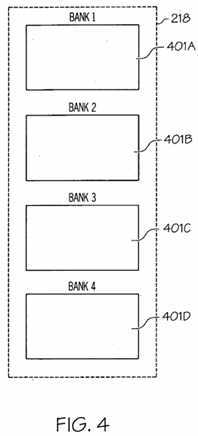
However, conflict detection still needs to be performed to determine if there any violations in executing a?load?or?store instruction. For example, a?load?instruction to a particular address should not be executed if there are unissued older?store instructions that will overlap in the addresses. A discussion of handling conflict detection using the unordered?load/store queue?218?is provided below in connection with?FIGS. 5,?6A-B and?7.?FIG. 5?illustrates the internal architecture of?load/store queue?218?in accordance with an embodiment of the present invention.?FIGS. 6A-B?are a flowchart of a method for providing full?load/store?queue?functionality to an unordered?load/store?queue?in connection with arriving?load?instructions for a processor with out-of-order execution.?FIG. 7?is a flowchart of a method for providing full?load/store?queue?functionality to an unordered?load/store?queue?in connection with arriving?store?instructions for a processor with out-of-order execution.
FIG.?5—Internal Architecture of?Load/Store?Queue
FIG. 5?illustrates the internal architecture of?load/store?queue?218?in accordance with an embodiment of the present invention. Referring to?FIG. 5,?load/store?queue?218?may include a content-addressable memory?501?referred to herein as "Address CAM." In one embodiment, Address CAM?501?may include the addresses of the?load?or?store?instructions executed. Address CAM?501?may be configured to receive the address of the current?load?or?store?instruction to be executed. Address CAM?501?may further be configured to search its entire memory to determine if that address (or an address that contains that address) is stored anywhere in it. If the same or overlapping address is found, then Address CAM?501?returns a bit mask which identifies the entries in Address CAM?501?that contain the same or overlapping address of the address of the?load?or?store?instruction to be executed.
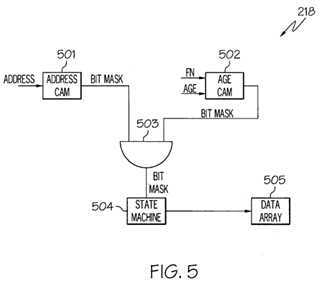
Load/store?queue?218?may further include a second content-addressable memory?502, referred to herein as "Age CAM." In one embodiment, Age CAM?502?may include the sequence number (i.e., the program order) of the?load?or?store?instructions executed. Age CAM?501?may be configured to receive the sequence number (i.e., the program order) of the current?load?orstore?instruction to be executed (identified as "age" in?FIG. 5) as well as an indication as to whether younger or older instructions with respect to the provided sequence number are to be searched (indicated as "fn" for function in?FIG. 5). For example, if a?load?instruction is to be executed, then the nearest oldest address of a?store?instruction for the same or overlapping address may need to be identified in order to determine if the data to be loaded is the latest or not. In another example, if a?store?instruction is to be executed, then younger executed?load?instructions to the same or overlapping address need to be identified to determine if incorrect data was previously loaded thereby resulting in the flushing of the pipelines.
Age CAM?502?may be configured to search its entire memory to determine if younger or older sequence numbers (based on whether Age CAM?502?is to search for younger or older sequence numbers than the sequence number provided) is stored anywhere in it. Age CAM?502?returns a bit mask which identifies the entries in Age CAM?502?that contain zero or more younger or older sequence numbers than the sequence number provided.
The output of Address CAM?501?and the output of Age CAM?502?are logically ANDed by logical AND gate?503. The bit mask outputted by AND gate?503?may be stored in a register (not shown) in state machine?504?(discussed further below). In one embodiment, the entries in Address CAM?501?and Age CAM?502?are correlated meaning that the first entry in Address CAM?501?that stores an address corresponds to the same instruction whose age is stored in the first entry in Age CAM?502. As a result, the?load?and?store?to the same address is physically co-located with one another which allows address comparison and the ability to perform a conflict detection analysis (e.g., to determine if a violation has occurred). By logically ANDing the output of Address CAM?501?and Age CAM?502, a conflict detection analysis is performed on the appropriate?load?or?store?instructions by a state machine?504?which is discussed in further detail below in connection with FIGS. 6A-B?and?FIG. 7. State machine?504?may be implemented via hardware, software, or a combination of hardware and software. State machine?504?may be configured to retrieve data from an appropriate entry in data array?505?as discussed further below in connection with?FIGS. 6A-B.
While the foregoing has described?load/store?queue?218?as including two separate content addressable memories, the principles of the present invention may applied to a single content addressable memory that performs the functions of Address CAM?501?and Age CAM?502.
FIGS.?6A-B—Method for Providing Full?Load/Store?Queue?Functionality to an Unordered?Load/Store?Queue?in Connection with Arriving?Load?Instructions
FIGS. 6A-B?are a flowchart of a method?600?for providing full?load/store?functionality to an unordered?load/store?queue?218(FIGS. 2-5) in connection with arriving?load?instructions for a processor with out-of-order execution in accordance with an embodiment of the present invention.
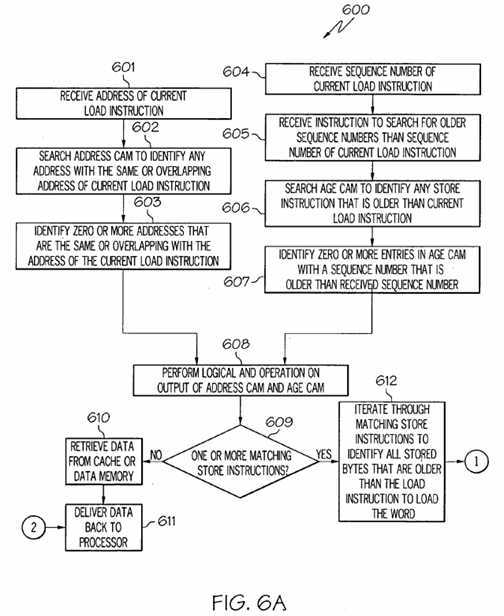
Referring to?FIG. 6A, in conjunction with?FIGS. 2 and 5, in step?601, an address of the current?load?instruction to be executed is received.
In step?602, a search is performed in Address CAM?501?to identify any address with the same or overlapping address of the current?load?instruction to be executed.
In step?603, zero or more entries in Address CAM?501?are identified with an address that is the same or overlapping with the address of the current?load?instruction to be executed.
In one embodiment, steps?604-607?are simultaneously executed in parallel with the searching in Address CAM?501?(steps601-603).
Referring to?FIG. 6A, in conjunction with?FIGS. 2 and 5, in step?604, a sequence number of the current?load?instruction to be executed is received. In step?605, an instruction to search for older sequence numbers than the received sequence number is received.
In step?606, a search is performed in Age CAM?502?to identify any entries with a sequence number that are older than the received sequence number. That is, a search is performed in Age CAM?502?to identify any?store?instructions that are older than the current?load?instruction.
In step?607, zero or more entries in Age CAM?502?are identified with a sequence number that are older than the received sequence number.
In step?608, a logical AND operation is performed on the output of Address CAM?501?and the output of Age CAM?502.
State machine?504?performs the following analysis to perform the functions of?load/store?queue?218?as previously discussed.
In step?609, state machine?504?determines whether there are one or more matching?store?instructions. For example, there may have been no entries identified in Address CAM?501?with the same or overlapping address as the address of the?loadinstruction to be executed. Further, if the search finds no matching?store?instructions, then there is no forwarding of data from the?store?instructions in?load/store?queue?218?to the?load?instruction. When no matching?store?is found, state machine504, in step?610, retrieves the data from the appropriate entry from data cache?215?or from memory?217.
In step?611, state machine?504?delivers the data back to processor?101.
If, however, one or more matching?store?instructions were identified, then, in step?612, state machine?504?iterates through the matching?store?instructions to identify all the stored bytes of a word that are older than the?load?instruction to?load?the word.
For example, suppose a?load?instruction is to be executed to?load?data from address x. Suppose further that state machine504?determines that the only uncommitted older?store?to address x has its address stored in entry #3?in Address CAM?501and its sequence number stored in entry #3?in Age CAM?502. State machine?504?may then retrieve the data stored in entry #3?from data array?505.
In another example, suppose that a?load?instruction is to?load?a word beginning at address x. One may need to know if data has been stored at each of the four bytes beginning at address x (e.g., x, x+1, x+2 and x+3, where x corresponds to the first byte of the word; x+1 corresponds to the second byte of the word; x+2 corresponds to the third byte of the word; and x+3 corresponds to the fourth byte of the word). If there are uncommitted stores to a portion of the bytes of the word (e.g., older stores to bytes x, x+2 and x+3 have been committed), then the missing bytes of data (e.g., x+1) may have to be retrieved from memory (e.g., data cache?215). As discussed above in connection with step?602?of?FIG. 6A, Address CAM501?is searched for the same or overlapping address of the address of the current?load?instruction. If the word?loadinstruction was the current?load?instruction, then a search may be performed in Address CAM?501?for the same address (e.g., address x) and the overlapping addresses (e.g., addresses x+1, x+2 and x+3). The above analysis regarding overlaps with older uncommitted stores may be performed for each byte in the word to be loaded. It is noted that the?loadinstruction is not limited to loading a word of four bytes. For example, the word to be loaded may be a half-word, a quad-word, etc. Further, state machine?504?may be configured in step?612?to match the corresponding types of prior stores (e.g., half-word, quad-word) to the loaded word.
Referring to?FIG. 6B, in step?613, state machine?504?determines whether there are any missing stored bytes in the word. If there are missing stored bytes in the word, then, in step?614, state machine?504?retrieves the missing bytes from a data memory or from data cache?215. Further, in step?615, state machine?504?retrieves the bytes, if any, that are not missing from?load/store?queue?data array?505. State machine?504?may then deliver the data back to processor?101?in step?611.
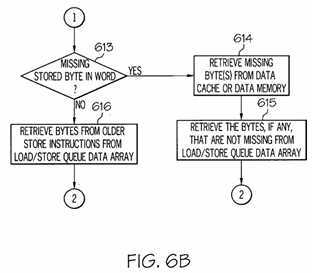
If, however, there no missing bytes, then, in step?616, state machine?504?retrieves the bytes from the older?storeinstructions from?load/store?queue?data array?505. State machine?504?may then deliver the data back to processor?101?in step?611.
Further, for systems that require program ordering between two?load?instructions to the same address, method?600?may be extended to check for?load-load?ordering violations and trigger recovery in a similar fashion as discussed below in connection with method?700.
Method?600?may include other and/or additional steps that, for clarity, are not depicted. Further, method?600?may be executed in a different order presented and that the order presented in the discussion of?FIGS. 6A-B?is illustrative. Additionally, certain steps in method?600?may be executed in a substantially simultaneous manner or may be omitted.
As discussed above, the method for providing full?load/store?queue?functionality to unordered?load/store?queue?218?in connection with arriving?store?instructions is provided below in connection with?FIG. 7.
FIG.?7—Method for Providing Full?Load/Store?Queue?Functionality to an Unordered?Load/Store?Queue?in Connection with Arriving?Store?Instructions
FIG. 7?is a flowchart of a method?700?for providing full?load/store?functionality to an unordered?load/store?queue?218?(FIGS. 2-5) in connection with arriving?store?instructions for a processor with out-of-order execution in accordance with an embodiment of the present invention.
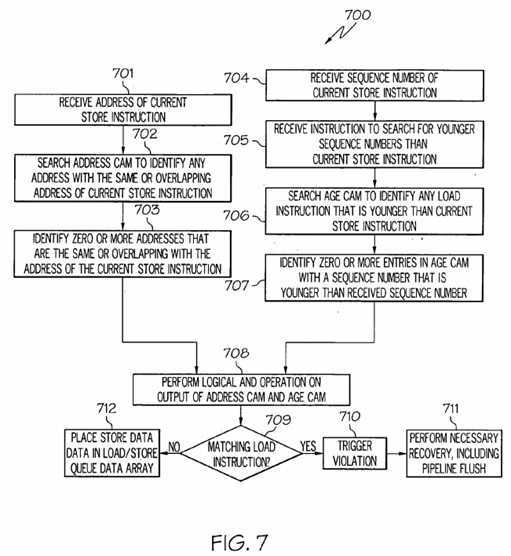
Referring to?FIG. 7, in conjunction with?FIGS. 2 and 5, in step?701, an address of the current?store?instruction to be executed is received.
In step?702, a search is performed in Address CAM?501?to identify any address with the same or overlapping address of the current?store?instruction to be executed.
In step?703, zero or more entries in Address CAM?501?are identified with an address that is the same or overlapping with the address of the current?store?instruction to be executed.
In one embodiment, steps?704-707?are simultaneously executed in parallel with the searching in Address CAM?501?(steps701-703).
Referring to?FIG. 7, in conjunction with?FIGS. 2 and 5, in step?704, a sequence number of the current?store?instruction to be executed is received. In step?705, an instruction to search for younger sequence numbers than the received sequence number is received.
In step?706, a search is performed in Age CAM?502?to identify any entries with a sequence number that are younger than the received sequence number. That is, a search is performed in Age CAM?502?to identify any?load?instructions that are younger than the current?load?instruction.
In step?707, zero or more entries in Age CAM?502?are identified with a sequence number that are younger than the received sequence number.
In step?708, a logical AND operation is performed on the output of Address CAM?501?and the output of Age CAM?502.
State machine?504?performs the following analysis to perform the functions of?load/store?queue?218?as previously discussed.
In step?709, state machine?504?determines whether there is a matching?load?instruction.
If there is a matching?load?instruction, then, in step?710, state machine?504?triggers a violation. For example, if a younger load?instruction was executed prior to the?store?instruction being executed, then a violation has occurred as incorrect data was loaded. In step?711, state machine?504?performs the appropriate action to handle the violation, such as by flushing the processor pipelines of at least the violating?load?instruction and everything younger, including the contents of?load/store queue?218.
If, however, there is no matching?load?instruction, then, in step?712, state machine?504?places the stored data in?load/store queue?data array?505.
Method?700?may include other and/or additional steps that, for clarity, are not depicted. Further, method?700?may be executed in a different order presented and that the order presented in the discussion of?FIG. 7?is illustrative. Additionally, certain steps in method?700?may be executed in a substantially simultaneous manner or may be omitted.
Although the method and processor are described in connection with several embodiments, it is not intended to be limited to the specific forms set forth herein, but on the contrary, it is intended to cover such alternatives, modifications and equivalents, as can be reasonably included within the spirit and scope of the invention as defined by the appended claims. It is noted that the headings are used only for organizational purposes and not meant to limit the scope of the description or claims.
SRC=https://www.google.com.hk/patents/US20090013135
标签:des style blog http color io os ar for
原文地址:http://www.cnblogs.com/coryxie/p/4023269.html